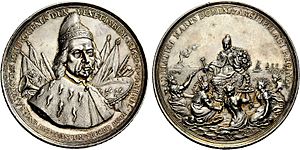Francesco Morosini facts for kids
Quick facts for kids
Francesco Morosini
|
|
|---|---|

Portrait by Gregorio Lazzarini, 1694
|
|
| Doge of Venice | |
| In office 1688–1694 |
|
| Preceded by | Marcantonio Giustinian |
| Succeeded by | Silvestro Valier |
| Personal details | |
| Born | 26 February 1619 Venice, Republic of Venice |
| Died | 6 January 1694 (aged 74) Nauplia, Republic of Venice |
| Spouse | celibate |
Francesco Morosini (born February 26, 1619 – died January 16, 1694) was a very important leader from Venice. He became the Doge of Venice in 1688 and served until 1694. This was during a big war called the Great Turkish War. Francesco Morosini came from the noble Morosini family, which produced many leaders and generals for the Republic of Venice. People said he always wore red clothes. He also never went into battle without his pet cat beside him.
Contents
Early Life and Military Career
Francesco Morosini first became well-known as a military leader. He was the Captain-General of the Venetian forces. This was during the siege of Candia on the island of Crete. The Ottoman Empire was attacking. He had to surrender the city in the end. When he returned to Venice, some people accused him of being a coward. But he was found innocent after a quick trial.
In 1685, a new war started. It was called the Morean War. Morosini took charge of a fleet of ships against the Ottomans. Over the next few years, he won many battles. He captured an area called the Morea. He also took Lefkada and parts of western Greece. He even briefly captured Athens in 1687. But he could not hold onto it for long. He also tried to capture the fortress of Negroponte but failed.
His fame grew so much that he was given a special title. It was Peloponnesiacus. This means "Conqueror of the Peloponnese" (another name for the Morea). He was also the first Venetian citizen to have a bronze statue made of him while he was still alive. It was placed in the Great Hall in Venice.
The Parthenon and Ancient Sculptures
During the Morean War, the Parthenon in Athens was used by the Ottoman Army. They stored gunpowder inside it. On September 26, 1687, Venetian forces were attacking Athens. Their cannons fired a shot that hit the Parthenon directly. This caused a big explosion and damaged the ancient building. A Swedish officer wrote that his general was sad to see the beautiful temple destroyed. But Morosini saw it as a "fortunate shot" in his report.
When Morosini's forces took control of the Acropolis in early 1688, he tried to move some sculptures. These were horses and chariots from the western part of the Parthenon. But the sculptures fell to the ground and broke. This was the first time anyone tried to remove these specific sculptures.
The Ottomans took back control of the monument the next year. They noticed the damage. They then started selling pieces of the monument as souvenirs. Morosini also took a large lion statue, known as the Piraeus Lion. He brought it back to the Venetian Arsenal as a war prize.
Becoming Doge of Venice
In the summer of 1688, Morosini was chosen as the new Doge of Venice. This was a very high honor. As Doge, he again attacked Negroponte. But he could not capture it. He had to go back to Venice because a sickness, like the plague, spread among his soldiers.
He started one last military campaign in 1693. Again, he was not able to take Negroponte. He returned to Venice after attacking some smaller towns along the coast. He passed away in 1694. A large marble arch was built in his honor at the Doge's Palace, Venice. His beloved cat, Nini, was also preserved. Nini was embalmed with a mouse between her paws. You can see Nini and the mouse today at the Museo Correr in Venice.
Remembering Francesco Morosini
- The Scuola Navale Militare Francesco Morosini is a military naval school named after him.
- Two Italian warships were named in his honor.
- The Ruggiero di Lauria-class ironclad Francesco Morosini was launched in 1885.
- Another battleship, the Francesco Caracciolo-class battleship Francesco Morosini, was planned in 1915. However, it was never finished.
See also
 In Spanish: Francesco Morosini para niños
In Spanish: Francesco Morosini para niños
| Political offices | ||
|---|---|---|
| Preceded by Marcantonio Giustinian |
Doge of Venice 1688–1694 |
Succeeded by Silvestro Valiero |


